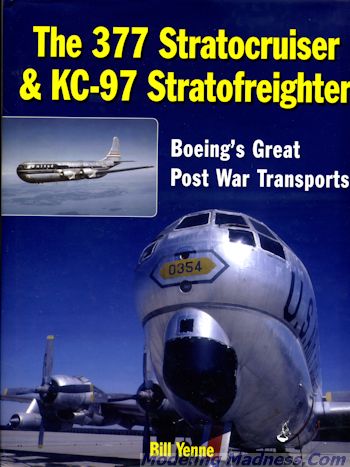
Crecy's The 377 Stratocruiser & KC-97 Stratotanker
|
Author: |
Bill Yenne |
|
Publisher |
Crecy Publishing |
|
Price |
$39.95 from Specialty Press |
|
Reviewer: |
|
| Notes: | ISBN 978-0-85979-179-3, 208 pages, 300 images |

Boeing was not always the American leader in airliners. Back in the 1930's they produced the model 247, a low wing, twin engine, passenger liner with retractable landing gear. It was fast, fairly comfortable and had the misfortune of coming out at about the same time as the Douglas DC-2, which eclipsed the 247 in every way. Not only that, but Boeing only sold the 247 to United Airlines, which at the time was owned by Boeing. Douglas did not have such restrictions and the DC-2 morphed into the DC-3 and the rest is history.
Even after the DC-3, Douglas maintained its lead with the DC-4/6/7 series. It was not until Boeing brought out its -80 which became the 707 that Boeing took the lead in airliners. But I digress. Let's back up to the early 1940s. Boeing wanted in the airliner business and their follow-on land based airliner, the model 307, was based on the B-17, but was stifled because of the war and lack of orders. It was felt that something better was needed and so development of a pressurized airliner that would fly above the weather was started.
Naturally, this was put on the slow track because of the war as Boeing was busy building B-17s and B-29s for the war effort. As nice as a very long range transport would be, the US military already had enough transports in the C-47 and the C-54 to handle what was needed and did not want Boeing sidelined from their bomber programs.
Eventually, Boeing was able to sell the idea of a large, pressurized transport and the C-97 was born. Initially powered by the same engines as the B-29 (in fact, all the flight surfaces were pretty much taken from this plane), the first XC-97 flew in late 1944. So slow was the development of the C-97, that the YC-97s did not fly until after the war and the YC-97As (with a taller fin) even later).
Meanwhile the commercial version, the model 377, was taking form. The idea of flying non-stop coast to coast was very appealing and Boeing got several airlines interested enough to make orders. The aircraft was able to fly the Atlantic as well, and while it had to stop for refueling on the westward journey, heading east could be done non-stop (thanks to the jetstream). Flights from the west coast to Hawaii also became routine.
Flying in the early 1950s was not the sardine can experience of today. Stratocruisers were designed to be first class all the way and included an in-flight lounge in the lower section. Boeing ran into criticism due to the delay in providing aircraft to buyers, and there were some issues with engines, but in the end the 377 was successful. What killed it was the 707, which put an end to all long haul recip airliners. The Stratocruiser was later converted to people packer configuration, cargo planes and several were heavily modified into large lifters in the forms of the Guppy and Super Guppy, all of which is covered in the book.
On the military side, having long range transports was always a good thing for the military and while purchases were meager by WWII standards, a goodly number were purchased and proved to be excellent medivac aircraft, thanks to their long range and ability to hold a number of stretcher patients. Some were also converted to aerial command posts with SAC, but the major production version, which ran into the 800s was the KC-97. SAC's large and growing bomber force needed air refueling to be a viable deterrent. Even after replaced by the KC-135, the KC-97 stayed in service with the ANG into the 1970s.
The book covers the previous history of Boeing and airliners, followed by the development of the aircraft for both military and civilian customers. Rather than concentrating on one version or the other, the book blends in the use of both types as time goes on. For instance, it covers the glory days of the Stratocruiser and then the KC-97, then back to the Stratocruiser as it loses its premier status. Same with the KC-97. There is also a nice section on the development of the Guppy and Super Guppy aircraft, one of which is still flying with NASA. All of this is enhanced by a superb selection of photographs as well as sections from brochures when it comes to the airliner versions.
In all, it makes for an excellent read though I have to comment on one thing I noticed. For some reason, the editor or author seems to think that flying from New York to London is a transpacific flight. Everywhere the word 'transatlantic' should have been used, there is the wrong word. Minor thing as I knew what they were talking about, but still rather distracting due to its many uses in the early chapters. Despite this glitch, it is a great book and one that I have no trouble highly recommending to you.
September 2014
Review book courtesy of
![]() ,
where you can order your copy of this and many other superb aviation and
modeling books. Visit their website at the link above or call them at
1-800-895-4585
,
where you can order your copy of this and many other superb aviation and
modeling books. Visit their website at the link above or call them at
1-800-895-4585
If you would like your product reviewed fairly and quickly, please contact me or see other details in the Note to Contributors.